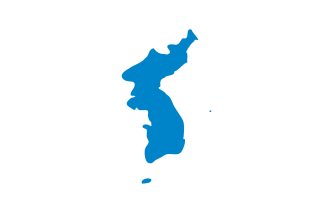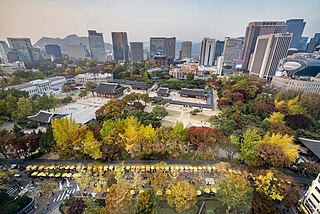Related Research Articles

Korea is a peninsular region in East Asia consisting of the Korean Peninsula, Jeju Island, and smaller islands. Since the end of World War II in 1945, it has been politically divided at or near the 38th parallel; in 1948, two states declared independence, both claiming sovereignty over the entire region: North Korea in its northern half and South Korea in the south, which fought the Korean War from 1950 to 1953. The region is bordered by China to the north and Russia to the northeast, across the Amnok (Yalu) and Duman (Tumen) rivers, and is separated from Japan to the southeast by the Korea Strait.

South Korea, officially the Republic of Korea (ROK), is a country in East Asia. It constitutes the southern half of the Korean Peninsula and borders North Korea along the Korean Demilitarized Zone; though it also claims the land border with China and Russia. The country's western border is formed by the Yellow Sea, while its eastern border is defined by the Sea of Japan. South Korea claims to be the sole legitimate government of the entire peninsula and adjacent islands. It has a population of 51.96 million, of which half live in the Seoul Capital Area, the ninth most populous metropolitan area in the world. Other major cities include Busan, Daegu, and Incheon.

The Lower Paleolithic era on the Korean Peninsula and in Manchuria began roughly half a million years ago. The earliest known Korean pottery dates to around 8000 BC and the Neolithic period began thereafter, followed by the Bronze Age by 2000 BC, and the Iron Age around 700 BC. The Paleolithic people are likely not the direct ancestors of the present Korean people, but their direct ancestors are thought to be the Neolithic People of about 2000 BC.

Busan, officially Busan Metropolitan City, is South Korea's second most populous city after Seoul, with a population of over 3.3 million inhabitants as of 2024. Formerly romanized as Pusan, it is the economic, cultural and educational center of southeastern South Korea, with its port being South Korea's busiest and the sixth-busiest in the world. The surrounding "Southeastern Maritime Industrial Region" is South Korea's largest industrial area. The large volumes of port traffic and urban population in excess of 1 million make Busan a Large-Port metropolis using the Southampton System of Port-City classification. As of 2019, Busan Port is the primary port in Korea and the world's sixth-largest container port.

Nam June Paik was a South Korean artist. He worked with a variety of media and is considered to be the founder of video art. He is credited with the first use (1974) of the term "electronic super highway" to describe the future of telecommunications.

The Yayoi period started in the late Neolithic period in Japan, continued through the Bronze Age, and towards its end crossed into the Iron Age.

Gangwon Province, officially Gangwon State (강원특별자치도), is a Special Self-Governing Province of South Korea. It is known as the largest and least densely populated subdivision of South Korea. Gangwon is one of the three provinces in South Korea with special self-governing status, the others being Jeju Province and Jeonbuk State. Gangwon is bordered on the east by the Sea of Japan, it borders Gyeonggi Province to the west, North Gyeongsang Province and North Chungcheong Province to the south, and the Military Demarcation Line to the north, separating it from North Korea. In the 1945 division of Korea, the historical Gangwon Province was divided in half, and remains so to this day.

South Gyeongsang Province is a province in the southeast of South Korea. The provincial capital is at Changwon. It is adjacent to the major metropolitan center and port of Busan. The UNESCO World Heritage Site Haeinsa, a Buddhist temple that houses the Tripitaka Koreana and tourist attraction, is located in this province. Automobile and petrochemical factories are largely concentrated along the southern part of the province, extending from Ulsan through Busan, Changwon, and Jinju.

Gyeonggi Province is the most populous province in South Korea.

Daegu, formerly spelled Taegu and officially Daegu Metropolitan City (대구광역시), is a city in southeastern South Korea.
Buddhist temples are an important part of the Korean landscape. Most Korean temples have names ending in -sa, which means "monastery" in Sino-Korean. Many temples participate in the Templestay program, where visitors can experience Buddhist culture and even stay at the temple overnight.

From 1910 to 1945, Korea was ruled as a part of the Empire of Japan under the name Chōsen (朝鮮), the Japanese reading of "Joseon".

Cheongju is the capital and largest city of North Chungcheong Province in South Korea.

Wonju is the most populous city in Gangwon Province, South Korea, with a population of 364,860 as of 2023. The city is located approximately 140 kilometres (87 mi) east of Seoul.

Celadon is a term for pottery denoting both wares glazed in the jade green celadon color, also known as greenware or "green ware", and a type of transparent glaze, often with small cracks, that was first used on greenware, but later used on other porcelains. Celadon originated in China, though the term is purely European, and notable kilns such as the Longquan kiln in Zhejiang province are renowned for their celadon glazes. Celadon production later spread to other parts of East Asia, such as Japan and Korea, as well as Southeast Asian countries, such as Thailand. Eventually, European potteries produced some pieces, but it was never a major element there. Finer pieces are in porcelain, but both the color and the glaze can be produced in stoneware and earthenware. Most of the earlier Longquan celadon is on the border of stoneware and porcelain, meeting the Chinese but not the European definitions of porcelain.

The United Nations Service Medal Korea (UNSMK) is an international military decoration established by the United Nations on December 12, 1950 as the United Nations Service Medal. The decoration was the first international award ever created by the United Nations and recognized the multi-national defense forces which participated in the Korean War.

The EMD SW8 is a diesel switcher locomotive manufactured by General Motors Electro-Motive Division and General Motors Diesel between September 1950 and February 1954. Power is supplied by an EMD 567B 8-cylinder engine, for a total of 800 hp (600 kW). A total of 309 of this model were built for United States railroads and 65 for Canadian railroads. Starting in October 1953 a number of SW8s were built with either the 567BC or 567C engine.

Tourism in South Korea and its industry caters to both foreign and domestic tourists. In 2023, 17.2 million foreign tourists visited South Korea, making it the 20th most visited country in the world. Most non-Korean tourists come from East Asia and North America, such as Taiwan and the United States. The popularity of Korean popular culture, often known as the "Korean Wave", in countries around the world has significantly increased tourist arrivals.

The Department of Asia in the British Museum holds one of the largest collections of historical objects from Asia. These collections comprise over 75,000 objects covering the material culture of the Asian continent, and dating from the Neolithic age up to the present day.

Seoul, officially Seoul Special Metropolitan City, is the capital and largest city of South Korea. The broader Seoul Capital Area, encompassing Gyeonggi Province and Incheon, emerged as the world's sixth largest metropolitan economy in 2022, trailing behind Paris, San Francisco, Los Angeles, Tokyo, and New York, and hosts more than half of South Korea's population. Although Seoul's population peaked at slightly over 10 million, it has gradually decreased since 2014, standing at approximately 9.97 million residents as of 2020. Seoul is the seat of the South Korean government.
References
- ↑ Yoo, Theodore Jun (2022-09-27). The Koreas: The Birth of Two Nations Divided. Univ of California Press. p. 211. ISBN 978-0-520-39168-0.